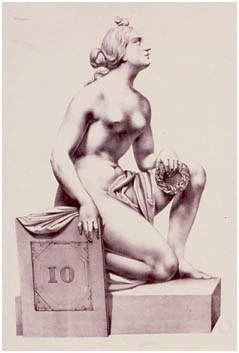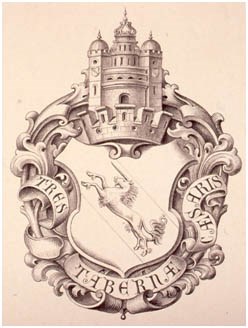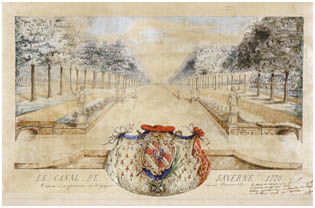
 ETAPE 1 Trouvez la déesse. En sortant de l’Office de Tourisme prenez à gauche vers ce point (N48° 44.464 E 007° 21.779).
ETAPE 1 Trouvez la déesse. En sortant de l’Office de Tourisme prenez à gauche vers ce point (N48° 44.464 E 007° 21.779).
Vous trouverez une statue : la « Hora »
Que représente cette déesse :
- L’amour (A=2)
- La musique (A=6)
- Le temps (A=3)
La statue représente une jeune fille agenouillée, tenant une couronne d'épines et un calendrier. Réalisée en 1841 par André Friedrich qui a aussi réalisé la Licorne de la place du Château, cette statue ornait au début du siècle le pont enjambant la Zorn dans la rue de la Gare. Elle a été placée au square de Latouche en 1908, puis au musée de la ville. Aujourd'hui elle coule des jours paisibles dans la zone piétonne du centre-ville.
ETAPE 2 Un roi dans la ville. Allez à ce point : (N 48° 44.471 E 007° 21.863).
Sur le mur de la sous-préfecture se trouve une plaque commémorant la venue du roi Charles X à Saverne.
Quelle est la date de sa venue ?
- 16 mars 1354 (B=8)
- 06 septembre 1827 (B=2)
- 05 mai 2004 (B=5)
L’Oberhof, ou « petit château » est la première résidence des Princes-évêques, avant l’aménagement du château des Rohan. C’est l’évêque Guillaume de Diest, en conflit avec les habitants de Strasbourg, qui a fixé en 1417 le siège administratif de l’évêché à Saverne et sa résidence principale. Saverne restera la capital de l’évêché jusqu’à la Révolution française. Le bâtiment héberge actuellement la sous-préfecture.
ETAPE 3 Un message de bienvenue. Allez à ce point :N48° 44.424 E 007° 21.796
Sur le linteau d’une porte est inscrit :
« IN GOTTES NAMEN GEH HEREIN DER WILL MEIN GUTTER GONNER SEIN » (qu’il rentre au nom de Dieu, celui qui veut être mon bon protecteur)
Quelle date figure au dessus de ce texte ?
- 1564 (C=2)
- 1515 (C=7)
- 1664 (C=3)
ETAPE 4 Le siège de Saverne. Allez à ce point : N 48° 44.379 E 007° 21.794
A cet emplacement se situe une stèle commémorant la mort du Maréchal John Hepburn pendant le siège de Saverne en 1636.
Pendant la Guerre de 30 ans, la France combat contre l’empire d’Autriche. Saverne, occupé par les troupes impériales est prise d’assaut par les hommes du Roi Louis XV. L’assaut fût un échec, Hepburn fut tué et Turenne, qui commandait la troupe, y fut gravement blessé. Il fallut un siège de 40 jours pour que la ville se rende enfin.
Hepburn avait créé un régiment de soldats britanniques qui combattait avec la France. Ce régiment existe encore de nos jours. Il a participé entre autres au débarquement de Normandie ainsi qu’à la Guerre du Golf. C’est le plus ancien régiment d’infanterie britannique.
Quel est le nom de ce régiment ?
- la 2e DB (D=7)
- le Royal Scots (D=6)
- la Légion Etrangère (D=4)
ETAPE 5 Un peu d'architecture. Allez à ce point : N 48° 44.453 E 007 21.740
Sur cette maison du XVIème siècle, se situe un bel élément d’architecture. Quel est le nom de ce type d’ornement ?
- Un oriel (E=5)
- Une horloge (E=1)
- Un balcon (E=6)
Réservé aux demeures des riches notables, ce type de construction, outre l’aspect esthétique de la façade du bâtiment, permet de procurer d'un peu plus de clarté et de chaleur solaire à l’intérieur ainsi qu’une vue surplombante qui permet de surveiller la rue.
Cette maison, qui faisait partie d’un ensemble avec le n°13 de la rue des frères, appartenait à une famille noble alsacienne, les Rathsamhausen, qui possédaient de nombreuses terres dans le centre de l’Alsace.
ETAPE 6 L'affaire de Saverne. Allez à ce point :N 48° 44.466 E 007 21.680
La maison n’a pas beaucoup de caractère, mais c’est ici où habitait le lieutenant von Forstner qui est à l’origine de « l’Affaire de Saverne » en 1913.
L'affaire de Saverne est une crise politique qui s'est produite fin 1913 dans l'Empire allemand, à la veille de la Première Guerre mondiale. La crise s'est déclenchée lorsqu'un sous-lieutenant stationné à Saverne, ville de cantonnement de deux bataillons du 99e régiment d’infanterie prussien, a tenu des propos humiliants à l'égard de la population alsacienne provoquant la protestation des habitants. L'armée a réagi aux protestations par des actes arbitraires et, en majeure partie, illégaux, ce qui a provoqué une vague d’indignation à travers toute l’Allemagne à l’encontre de l’armée et de l’empereur.
Combien y-a-t’il de fenêtres murées ?
- Deux (F=5)
- Trois (F=2)
- Quatre (F=9)
ETAPE 7 Sur les traces du Vénérable. Allez à ce point : N 48° 44.604 E 007° 21.655
Sur la fontaine, se trouve l’effigie d’un célèbre père missionnaire du XIXème siècle. De qui s’agit-il ?
- le père Lachaise (G=5)
- le père Fouras (G=3)
- le père Libermann (G=8)
Né en 1802, fils du rabbin de Saverne, il se convertit au catholicisme et devient prêtre. Il mit en place une mission pour évangéliser les descendants des esclaves des colonies françaises, notamment en Haïti et à la Réunion. Il fonda la Société du Saint-Cœur de Marie qui fusionna plus tard avec la congrégation du Saint-Esprit.
La congrégation possède encore à Saverne un centre d’accueil, la « Maison Saint-Florent », où l’on peut découvrir une exposition sur le père ainsi qu’un musée d’art africain.
ETAPE 8 La légende de la Licorne. Allez à ce point : N 48° 44.599 E 007° 21.757

Selon la légende, la licorne aurait trempé sa corne dans l’eau de la source qui jaillit ici, la rendant miraculeuse. Dans l’antiquité, les romains y avaient installé des bains. Au Moyen-âge, des pèlerins emportaient de cette eau aux propriétés thérapeutiques. Pendant les travaux d’agrandissement des écuries du château, aujourd’hui école de musique, il aurait été retrouvé une dent de narval fossilisée, lançant probablement le début de cette légende… et les armes de la ville.
Quel est le nom de cette source (indice : regardez du coté du lavoir)
- Badbrunnen (H=1)
- Baden-Baden (H=8)
- Fontaine de jouvence (H=6)
Continuer votre promenade le long de la rivière pour atteindre le prochain point.
ETAPE 9 Le grand canal. Rendez-vous à ces coordonnées : N°48 44.618 E 007 21.962
 De cet emplacement, vous avez la plus belle vue sur le château des Rohan. Mais voyez-vous de l’autre coté cette double rangée d’arbres ? Avant que le canal de la Marne au Rhin et la ligne de chemin de fer ne furent construit, se dressait ici un des plus beaux parcs de France.
De cet emplacement, vous avez la plus belle vue sur le château des Rohan. Mais voyez-vous de l’autre coté cette double rangée d’arbres ? Avant que le canal de la Marne au Rhin et la ligne de chemin de fer ne furent construit, se dressait ici un des plus beaux parcs de France.
Après une succession de terrasses et de parterres, un canal se déroulait en ligne droite à partir de ce point sur une longueur de 4 km jusqu’au village de Steinbourg. Il permettait à l’évêque d’emmener ses invité en gondole jusqu’à une ile situé sur une grande rondelle d’eau.
De quels arbres s’agit’il ? :
A= chênes (I=5)
B = peupliers (I=2)
C = bouleaux (I=3)
ETAPE FINALE
Vous avez tous les indices. Le trésor se trouve aux coordonnées suivantes :
N 48° 44.(A+B)CD E 007° 22.(E-F)G(HxI)
Stage 1 : Find the goddess.
When you get out of the office , go on your left to this coordiantes : N48° 44.464 E 007° 21.779
You'll find the statue : the “Hora”
What this goddess represents ?
- Love (A = 2)
- Music (A = 6)
- Time (A=3)
The statue represents a young girl kneeling, holding a crown of thorns and a calendar. Made in 1841 by André Friedrich who also made the Unicorn Castle Square, the statue decorated the early twentieth century the bridge over the Zorn in the rue de la Gare. She was placed in square Latouche in 1908 and the museum of the city. Today she enjoys a peaceful day in the pedestrian zone from the city center.
Stage 2 : A king in the city.
Go to coordinates : N 48° 44.471 E 007° 21.863
On the wall of the sub-prefecture is a plate commemorating the visit of King Charles X in Saverne.
What is the date of his coming?
- 16 march 1354 (B=8)
- 06 september 1828 (B=2)
- 05 may 2004 (B=5)
The Oberhof, or “little castle” is the first residence of the Prince-Bishops, before development Rohan Castle. It was Bishop Guillaume Diest, in conflict with the inhabitants of Strasbourg, which in 1417 set the administrative seat of the bishopric in Saverne and his principal residence. Saverne remain the capital of the diocese until the French Revolution. The building currently houses the sub-prefecture.
Stage 3 : A welcome message.
Go to the coordinates : N48° 44.428 E 007° 21.785
On the lintel of a door is written :
« IN GOTTES NAMEN GEH HEREIN DER WILL MEIN GUTTER GONNER SEIN »
(he comes in the name of God, who wants to be my good protector)
What date is above this text ?
- 1564 (C=2)
- 1515 (C=7)
- 1664 (C=3)
Stage 4 : The siege of Saverne.
Go to the coordinates : N 48° 44.379 E 007° 21.794
At this location is a monument commemorating the death of Marshal John Hepburn during the siege of Saverne in 1636.
During the 30 Years War, France was fighting against the Austrian Empire. Saverne, occupied by imperial troops was stormed by the men of King Louis XV. The attack was a failure, Hepburn was killed and Turenne, who commanded the troops, was seriously injured. It took a siege of 40 days for the city to finally surrender.
Hepburn had created a regiment of British soldiers who fought with France. This regiment still exists today. He participated among others in the Normandy landings and the Gulf War. This is the oldest British infantry regiment.
What is the name of this regiment ?
- la 2e DB (D=7)
- le royal Scots (D=6)
- la légion étrangère (D=4)
Stage 5 : A bit of architecture
Go to the coordinates : N 48° 44.453 E 007 21.740
This house of the sixteenth century, is a beautiful piece of architecture. What is the name of this type of ornament ?
- An oriel (E=5)
- A clock (E=1)
- A balcony (E=6)
Reserved for rich houses of notables, this type of construction, besides the aesthetic appearance of the building facade, lets provide a little more clarity and solar warmth inside as well as overhanging view that allows to watch the street.
This house, which was part of a set with the No. 13 rue des frères, belonged to a noble Alsatian family, the Rathsamhausen, who owned a lot of land in the center of Alsace.
Stage 6 : The case of Saverne
Go to coordinates : N 48° 44.466 E 007 21.680
The house does not have much character, but this is where Lieutenant von Forstner was living who is the origin of "The case of Saverne" in 1913.
The case of Saverne is a political crisis that occurred end of 1913 in the German Empire on the eve of the First World War. The crisis was triggered when a second lieutenant stationed at Saverne, cantonment town of two battalions of the 99th Prussian Infantry Regiment, held humiliating comments towards the Alsatian population causing protests from residents. The army responded to the protests by arbitrary acts and, for the most part, illegal, causing a wave of indignation throughout Germany against the emperor army.
How many walled window can you see ?
- 2 (F=5)
- 3 (F=2)
- 4 (F=9)
Stage 7 : In the footsteps of the Venerable
Go to the coordinates : N 48° 44.604 E 007° 21.655
On the fountain, is the effigy of a famous missionary father of the nineteenth century. Who is it?
- le père Lachaise (G=5)
- le père Fouras (G=3)
- le père Libermann (G=8)
Born in 1802, son of the Rabbi of Saverne, he converted to Catholicism and became a priest. He set up a mission to evangelize the descendants of slaves in the French colonies, particularly in Haiti and Réunion. He founded the Society of the Holy Heart of Mary, who later merged with the Congregation of the Holy Spirit.
The congregation still has to Saverne the reception center "Saint-Florent House", where you can see an exhibition on the father and a museum of African art.
Stage 8 : The unicorn legend
Go to coordinates : N 48° 44.599 E 007° 21.757
According to legend, the unicorn would have dipped his horn in the source water that flows here, making it miraculous. In ancient times, Roman had installed baths there. In the Middle Ages, pilgrims carried away this water with therapeutic properties. During the expansion work of the stables of the castle, today th music school, it would have been found fossilized narwhal tooth, probably starting the beginning of this legend ... and the arms of the city.
What's the name of this source ? (Clue : look next to the laundry)
- Badbrunnen ou Badstube(H=1)
- Baden-Baden (H=8)
- Fountain of Youth (H=6)
Continue your walk along the river to reach the next point.
Stage 9 : The great canal
Go to coordinates : N°48 44.618 E 007 21.962
From this location, you have the most beautiful view of the castle of Rohan. But can you see on the other side of this double row of trees? Before the canal from the Marne to the Rhine and the railway line were built, stood here one of the most beautiful parks in France.
After a succession of terraces and flowerbeds a canal was going in a straight line from this point on a length of 4 km to the village of Steinbourg. It allowed the bishop to take his guest in gondola to an island located on a large washer water.
What kind of tree are they ?
A = oaks (I=5)
B = Poplar (I=2)
C = Birch (I=3)
Final Stage !
You have find all the clues. The treasure is at the coordinates below :
N 48° 44.(A+B)CD E 007° 22.(E-F)G(HxI)
